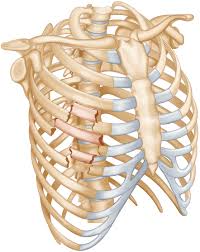 Flail chest is a life-threatening medical condition.
Flail chest is a life-threatening medical condition.
It occurs when a segment of the rib cage breaks due to trauma and becomes detached from the rest of the chest wall.
Approximately 1 out of 13 people admitted to the hospital with fractured ribs are found to have flail chest.
The symptoms of flail chest are chest pain and shortness of breath.
It occurs when multiple adjacent ribs are broken in multiple places, separating a segment, so a part of the chest wall moves independently.
It typically occurs when three or more adjacent ribs are fractured in two or more places, allowing that segment of the thoracic wall to displace and move independently of the rest of the chest wall.
At least two adjacent ribs are broken in at least two places,
Some authorities suggest three or more ribs in two or more places be affected.
The flail segment moves in the opposite direction to the rest of the chest wall.
The ambient pressure in comparison to the pressure inside the lungs, moves in while the rest of the chest is moving out, and vice versa with breathing.
Such paradoxical breathing is painful and increases the work involved in breathing.
Flail chest is usually accompanied by a pulmonary contusion and that could be the main cause of respiratory problems in people with both injuries.
The paradoxical motion of the flail segment occurs due to pressure changes associated with respiration that the rib cage normally resists.
During normal inspiration, the diaphragm contracts and intercostal muscles pull the rib cage out, the pressure in the thorax decreases below atmospheric pressure, and air rushes in through the trachea.
The flail segment, however, will be pulled in with the decrease in pressure while the rest of the rib cage expands.
During normal expiration, the diaphragm and intercostal muscles relax increasing internal pressure, allowing the abdominal organs to push air upwards and out of the thorax.
However, with a flail segment it will be pushed out while the rest of the rib cage contracts.
The sharp broken edges of the ribs could puncture the pleural sac and lung, possibly causing a pneumothorax.
Pulmonary contusions are commonly associated with flail chest.
Respiratory failure can occur due to the paradoxical motions of the chest wall from the fragments interrupting normal breathing and chest movement.
Paradoxical chest movements is associated with stiff lungs, increased lung resistance making breathing more difficult.
Respiratory failure from a flail chest may require mechanical ventilation
Damage caused to the lungs from the flail segment may be life-threatening.
Vehicle collisions are the most common cause of flail chest, accounting for 76% of such injuries.
Falls in the elderly are also a common cause of flail chest injury, related to weak and frail bones.
Falls account for 14% of flail chest injuries.
Flail chest can also occur when ribs are fractured proximally in conjunction with disarticulation of costal cartilages distally.
This type of injury can be caused by forceful accidents such as vehicle collisions or significant falls.
In the elderly flail chest can be caused by deterioration of bone.
In children, the majority of flail chest injuries result from common blunt force traumas or metabolic bone diseases, including osteogenesis imperfecta.
Diagnosis is by physical examination and assisted or confirmed by use of medical imaging with either plain X ray or CT scan.
Treatment
Treatment of the flail chest initially follows the principles of advanced trauma.
Pain management includes early regional anesthesia.
The avoidance of opioid pain medication as much as possible.
Pain management allows better ventilation, improved tidal volume, and increased oxygenation.
Positive pressure ventilation, chest tubes, aggressive pulmonary toilet are necessary.
With respiratory failure intubated with a double lumen tracheal tube may be needed: In a double lumen endotracheal tube, each lumen may be connected to a different ventilator if one side of the chest is affected more than the other.
Surgical fixation can help in significantly reducing the duration of ventilatory support and in conserving the pulmonary function.
Surgical intervention reduces the need for tracheostomy, reduces the time spent in the intensive care unit, and could reduce the risk of acquiring pneumonia after such an event.
Chest physiotherapy is important to reduce further complications: Proper positioning of the body for proper drainage of mucous secretions.
Breathing exercises are important in to allow the chest wall to reposition itself back to normal conditions.
The death rate with flail chest depends on the severity of their condition, ranging from 10 to 25%.
Review comparing the safety and effectiveness of surgical fixation versus non-surgical methods for the treatment of flail chest: no statistically significant difference in the reported deaths between patients treated surgically and those treated with conservative management methods.
